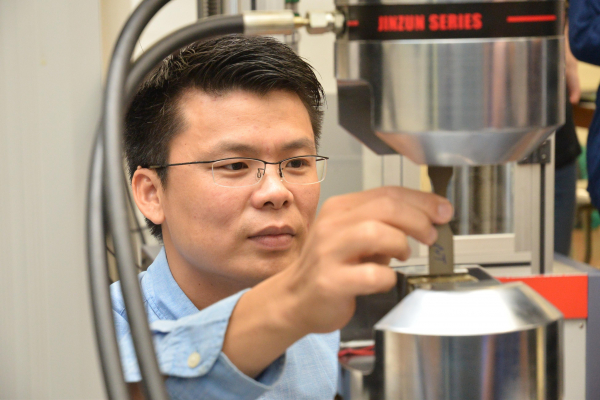Media
HKU Mechanical Engineering research team achieves breakthrough in
super lightweight automobile steels for next generation low emission automobiles
17 May 2015
Dr. Huang Mingxin, at the HKU Department of Mechanical Engineering, develops a new generation of ultrahigh strength steels
Automobiles can be made more environmentally friendly with better efficiency in fuel consumption and lower carbon emissions. One of the key solutions lies in the materials used. Car bodies made of ultrahigh strength steels are thinner and therefore lighter in weight but can still offer excellent crash performance and passenger protection. Lighter cars also cause less carbon emissions.
The last breakthrough in automobile steels, which are used in vehicles today including those top model green vehicles in the market, was made by scientists some ten years ago.
 The new generation of automobile steel (right) is only half as thick (1.00mm) as the steel now used in automobiles (left, 2.02mm), while offering the same strength and ductility
The new generation of automobile steel (right) is only half as thick (1.00mm) as the steel now used in automobiles (left, 2.02mm), while offering the same strength and ductility
A research team led by Dr. Huang Mingxin at the Department of Mechanical Engineering of the University of Hong Kong (HKU) has developed a new generation of ultrahigh strength steels. The innovation has met, 10 years in advance, the future technical targets for automobile materials proposed by the US Department of Energy and General Motors. Dr Huang’s team is among the first groups in the world to have achieved such a breakthrough in automobile materials. The new steels can be used for developing the next generation environmental friendly vehicles with lower carbon emissions and electric cars.
Comparing to one of the best automotive steels (QP980) available in the market, one of the new generation steels developed by the team (Transformation-induced plasticity (TRIP) steel), its ductility (the ability of a material to be elongated or deformed) is similar but the ultimate tensile strength (ability to resist fracture) is 50% higher. This project was funded by the HKSAR Innovation and Technology Fund, Baosteel in Mainland China and General Motors. The team is in the process of applying a US patent for the new technology.
In addition, the team has developed a higher graded nano-steel (nano-twinned steel), which has a similar ultimate tensile strength as TRIP, but possesses a higher yield strength (ability to resist deformation) and better ductility. This project was sponsored by the General Research Fund of the University Grants Council.
With the same crash performance and passenger protection capability, the car made with the two new steels could weight 30% less, consume 20% less fuel and produce 20% less emissions. Moreover, they can readily be produced making use of the existing facilities in steel plants, which can greatly shorten the time for the new products to be taken to market.
For media enquiries please contact Miss Nancy Cheung, Faculty of Engineering, HKU (Tel: 2219 4668 / E-mail: nccheung@hku.hk) or Ms Melanie Wan, Communications and Public Affairs Office, HKU (Tel: 2859 2600 / Email: melwkwan@hku.hk).


